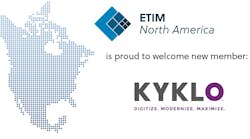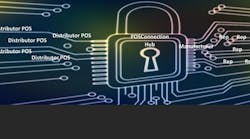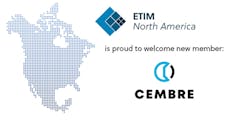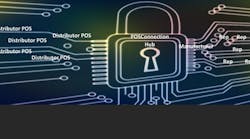Over the last several years, Electrical Wholesaling has listened to and related the predictions of industry leaders with respect to electronic commerce. Some were merely keeping a wary eye on its development, but most overwhelmingly agreed that it would be the way business was conducted in the future. Well folks, it would seem the future is now.
No longer are the industry giants, the Graybars and the Graingers, the sole participants in EDI, bar coding, Internet commerce and the like. With EDIPro standards firmly in place and business software providers well on board with EDI packages that allow virtually any distributor to transmit and receive data to and from any vendor, the small and mid-sized wholesalers are jumping into ether-business with both feet.
Rich Bolotsky, vice president, management information systems (MIS) at Good Friend Electrical Supplies, Inc., Toms River, N.J., says they have been using EDI for about three years, expanding trading partners as it makes sense to do so. Bolotsky is on the NAED's Technologies and Standards committee, and on a new UCC (Uniform Code Council) group that will do standards for the entire commercial and industrial sector. (See "EDI for All," page 36.)
He says it cost his company about $1,500 to get the software they chose (Gentran from Sterling Software) up and running on his system. Before EDI, they faxed orders into the manufacturer, but then it had to be re-keyed into the manufacturer's system, which paved the way for errors. Plus, he says faxes didn't always come through clearly or were misread, or communication broke down and the entire order was lost
"What EDI allows me to do is have the confidence that when data leaves my machine in a certain format it's understandable by my manufacturer," says Bolotsky. "They should be able to take it, ideally without human contact, into their system, dump it into the right buckets and get exactly what I told them."
Those who use EDI to its fullest potential can get acknowledgment that the purchase order was received, what is being shipped from the manufacturer, invoicing, etc.-all done electronically with little if any human interference. "Downstream this has huge implications for distributors," says Bolotsky. "Huge implications. And the biggest initial implication is the time savings it provides in getting material. But right now a lot of manufacturers aren't accepting anything except purchase orders through EDI. They're stopping at that point, so these greater benefits that will ultimately get to the distributor aren't getting there yet. But EDI is becoming more and more an implemented structure, and those that are not doing EDI are foolish."
"The manufacturers are the ones who really win in this situation," says Bolotsky. Some manufacturers are even offering a 1/2% rebate on all purchases made through EDI to encourage distributors to use it. "By not having to have humans key in this stuff, they reduce clerks. By not having humans who make errors keying in this stuff they reduce fixes and error correction. By not having clerks key this in, they reduce the time between when an order is issued by a distributor and when the order is active in their internal system. It cuts out a whole layer of human error. EDI is an important technology to go with, so we're doing it with all the vendors that it makes sense to go with. There are some vendors I have where, when I issue an order, literally 15 minutes after it leaves my machine, they are picking it in their warehouse."
But Bolotsky says that's not always the case. He says there are some vendors who say they have EDI, but what they really have is a PC that picks up the EDI data, and then they print it out and give it to a person who keys it in to their system. "It takes them longer to print it out and then key it in, than it does for me to fax it to them," says Bolotsky. "Its ridiculous, but the reason they do it is because somewhere in their marketing literature, or somewhere at a high level they want to be able to say, 'Oh, we do EDI.' That's the only reason they do it."
James Laner, president of Laner Electric Supply Co., Inc., Richmond, Calif., has had similar experiences. His company services small contractors, primarily in residential and light commercial, and grosses about $6 million in annual revenue. Laner is also a principal in a software company called Key Data Systems Group, San Francisco, that provides business software solutions.
"I do a lot of demos of our software, not electrical distributors necessarily, but a lot of different types of distributors," he says. "And I'll tell you what smacks me on the head about 70% or 80% of the time. The CEOs have no idea what a computer system should do for them. They don't understand what it's for. They don't understand that in order to be successful, they have to make the computer system the absolute core of everything they do. And all of their operational policies and procedures at the company have got to be structured so that the process is fed properly. If you put garbage in, you get garbage out. Many of them fail to realize this. And the ones that fail to realize this, I wonder, first of all how they're making any money, and I wonder second of all if they're going to be around two or three years from now. Most of the CEOs are very sales-oriented and they're entrepreneurial types. They don't want to take the time to make sure that their automation systems are in place. They're putting the cart before the horse."
Bolotsky says it is for that reason he doesn't do EDI with every manufacturer. "I don't do EDI where I don't see an advantage. The advantage must be, number one, that my order goes all the way through his system, so he doesn't add any people to edit it. The advantage is my order isn't held up because they couldn't figure out my price. If the manufacturer doesn't use UPC codes, I won't do EDI with him, because those are the backbone of identifying the products within the EDI environment. Saying those that don't use EDI are foolish, doesn't go hand-in-hand with saying you must do EDI with every single person possible. You must do EDI where ever it is reasonable."
Bilotsky's advice is to, first of all, get a good software package for internal business. "Go with a package that does everything you need it to do, not just one that's been around a long time," he says. "That's a purchasing and selection process." He says the distributors who have a package (such as Trade Service Systems' Array) have the easiest time with EDI because they don't have to do all the set up work. It's all been done. They just have to ask a trading partner if they use EDI and, if they do, they just press a button and go. Bolotsky says there is virtually no cost to someone who already has one of the fully integrated software packages that are out there. There are ongoing charges that exist outside of that, such as transmittal charges, document charges, etc. But Bolotsky says those distributors who are fortunate enough to have a package that can handle EDI well really don't have to know anything about EDI.
"Maybe my head's in the clouds or something, but I am under the impression that the EDIPro standard set significantly improved the ability for someone to go on EDI with various trading partners," Bolotsky says. "The reason is, if the preponderance of manufacturers comply with EDIPro, a distributor that has a system that's already functioning can go and say to a new manufacturer, a new trading partner, 'I want to do EDI with you.' If they both say, 'Yeah, we both talk the same language,' it almost becomes merely a matter of pressing a button and they're on." Bolotsky says he can turn on EDI with almost any manufacturer and be fully functioning, transmitting simple purchase orders, within one day because those common standards exist.
"That's the irony, says Bolotsky. "All they have to know about EDI is whether the vendor offers it or not. That's almost an ideal statement, though. All of those packages out there don't do it well. The thing is, because of this ignorance and lack of needing to know exactly what EDI is all about, some of these guys are on the wrong train track, but they still are doing EDI. They're not doing it well because they're constrained by impediments that their software provider has created. But anybody can do EDI."
The most primitive EDI set up, according to Bolotsky, is when someone gets a stand-alone PC, puts some EDI software on it, signs up with a value-added network and begins to use EDI. He says the problem is that, in those cases, if EDI is not tied to their host computer, they have to do what the manufacturers used to do. "They have to print out the P.O., then have a human key it into the machine, which defeats the purpose," he says. "Except that if you have 10 vendors that offer incentives to use EDI that can add up to $5,000, $6,000 or maybe $10,000 a year, then you can justify saying that it's worthwhile doing EDI with them. But that is the dumb way to do it."
Laner says a lot of people are making system-purchase decisions based to a large degree on how the system looks. "They're paying attention to the sizzle and not to the steak," he says. "They're paying way too much attention to what it takes to implement and administer that system and to get valuable information out of it once it's the core of their operation. Inexpensive, cheap software that never does what you want it to do is one thousand times more expensive than expensive software that does exactly what you need it to do."
Another technology that exists in this industry and is a parallel to EDI is bar coding. Bolotsky says problems are created in this area also by those who really won't jump all the way on board and do it right. He says a number of vendors bar code their merchandise, however the bar codes are not readable and so are not usable. "But if you talk to the vendor, to the president of the company, he or she is under the impression that they are bar-code compliant and use bar codes," says Bolotsky. So how does this happen?
"It's stupid stuff. It's basic stuff," he says. "A mandate comes down from the ivory tower that says, 'We must do this.' Then they undercapitalize it and don't do it correctly. They get the wrong people in to perform the program. The goals that are at the bottom line and the person who's actually brought in to make this happen are simply for appearance sake or whatever. Truth is stranger than fiction and this is truth. I can name three vendors right off the top of my head that have this same issue, and when you discuss it with them they give you all kinds of excuses. But the fact of the matter is, there are places out there that do it that way."
The problems arise because bar codes have a very specific spacing and density that's required in printing. There are standards in bar coding, just like there are in EDI. And the standards spell out the width and density-that's what makes the bar code readable or unreadable. There is also a certain spacing required at the beginning and end of the bar, so the bar code must be positioned on the label to provide for this spacing. Improper placement also makes the code unreadable.
"These are very high level standards, but they are not hard to get to," says Bolotsky. "In order to get there, there are tools called bar-code verifiers that can be used anywhere. They cost between a few hundred bucks to several thousand dollars depending on your production. And that's what needs to be important to the person who is providing these bar codes. If that device were used in every area where they produce bar codes, they would have 100% verifiable bar codes that could be read byvirtually any bar code device from here to Timbuktu. They just don't do it."
Bolotsky says another problem is what he calls a "push-pull" thing. "The manufacturers who are producing these crappy bar codes can say to all these uninitiated people who don't know anything about bar codes, 'We're bar code capable and functioning,' The vast preponderance of distributors who don't use bar codes think that's great. It's only the few distributors who actually try to use them who are aware. They're having to apply bar code labels over the bar codes that come from the manufacturers in order to utilize the bar coding." Bolotsky says because of this, manufacturers don't hear a hundred people complaining. "They only have a sense of the three or four or five instead of the other 95 who are calling up every week and bitching at them and saying to them, 'Why can't you spend the money and get a verifier?'" he says. "So you don't have that big push for it to be done right."
Good Friend Electrical uses bar codes at point-of-sale and during annual inventory so it's very clear to Bolotsky who produces good bar codes and who doesn't. He says that all these unreadable bar codes mean that any distributor who wants to use bar codes must scan each product to see if the bar code is readable, or has improper information. One manufacturer he knows put bar codes on all their stuff, and they were readable, but they put the same number on everything. "The bar codes had no significant meaning to anyone on earth," he says.
The people who do the best bar code implementation, according to Bolotsky, are those who use it internally for their own warehouse movement of material. And not all big manufacturers us them internally. "The irony is that you look at manufacturers with mega-megabucks and huge MIS centers, and you just smirk and say 'Why in the world can't all these things be right?'" Bolotsky says some manufacturers are totally disjointed regarding bar codes and UPC numbers. "I've had hundreds of items whose codes look good, but are totally unreadable by any bar code instrument because they're off. It's just so stupid. If they're going to go to all the trouble and expense of producing these label-application machines and printing this stuff, why don't they go that final degree of verifying it so that they're not producing tens of thousands of boxes of these things that are unusable."
Problems like this impede the progress of EDI, says Bolotsky, but if a distributor makes a commitment to use bar codes, he's not going to stop just because a few manufacturers can't get their act together. "If a distributor makes the investment to do warehouse management using bar codes, he's the one who knows very clearly how poor these bar codes are, but at that point he's not going to throw out all of his stuff and say, 'I'm not going to do it anymore,'" says Bolotsky. "He knows the advantages. Bar coding along with EDI are two technologies that truly reduce costs in the business and truly improve the ability to move stuff through the supply chain."
Laner has implemented a wireless bar code system at Laner Electric. The company is scheduled to do a full random physical count, and Laner says about 60% or 70% of the products will be counted through wireless bar code, including those products that actually have bar codes on them or which are in bins that have a bar-coded SKU on them.
"Our warehouse is completely location-driven," he says. "So if you go into our warehouse and look at our shelves, it looks like we've put stuff away in random fashion. But that's not the case. We keep track of every product's location. When we put stuff away, we put it in a place that's the right size for it." He says they do that simply by "eyeballing" it.
"Here's a box," he says. "And there's a hole on the shelf that's the right size for it. You put the box in the hole and record the location. And from that point on, we do our picking and our put-away by location. It allows you to make very efficient space utilization. It used to be that we would have to arrange our warehouse by vendor. All the Lamson and Sessions is over here, and all the Bridgeport is over there. And once you had that done, you would perhaps arrange everything by catalog number so you could find it. The problem is that catalog number 123 goes next to catalog number 124. Well, 123 is the size of a pea, and 124 is the size of a truck. And you've got 123 sitting on a pallet-rack just to make it easier to find. That problem is eliminated for us. We put 123 in a small-part bin in a random location within all the parts bins, and we log its location. From that point forward, anybody can find it."
Laner says that certainly the objective of a distributor management-information system is to handle the accounting requirements. But he says that in a wholesale-distribution, vertical package, accounting should be just a byproduct. "The real reason that you have the system is to manage your assets," he says. "To manage your accounts receivables, to manage your inventory. Those are the distributor's assets." He adds that, peripherally, you want to manage the interaction between your customers, your suppliers and your products, but the real goal is to reduce your inventory and to make sure that your cash-flow is well-managed.
The right system that helps forecast purchasing properly and helps to identify slow-moving products, properly implemented and properly managed, can result in a reduction in inventory value alone that can pay for a new system within a year to a year and a half, according to Laner. Laner says the carrying cost of inventory is huge according to Gordon Graham, a well-known inventory management consultant. "To figure the cost of carrying inventory, you take the prevailing prime rate and add about 15 or 20 points to it," says Laner. "Let's say today it's at 5%. So your annual carrying cost is 25%. If you can reduce a $3-million inventory by half a million bucks, you've just saved $125,000. Certainly EDI is a way to reduce transaction costs and error rates. Wireless bar coding and warehouse logistics systems are ways to reduce transaction costs, reduce error rates, increase accuracy, but also it allows you to manage your inventory. Thinking of every product in your warehouse as having a physical location makes it pretty darn hard to lose something. So, instead of reordering that thing that your customer needs that you can't find, you end up finding it and selling it rather than having two white elephants in your warehouse."
Essentially, Laner says buying the right system pays for itself just by virtue of what it does, and that it shouldn't be that big a lump to swallow up front. "The payback period shouldn't be that long. Wireless bar coding for us has been less than an 18-month payback. We're going to be able to accomplish a physical count in a much shorter period of time. We're not going to have to close during business hours. As far as the ongoing management, the real-time management of inventory location on the warehouse floor, a lot of man-hours are saved."
Bolotsky says a distributor must do more than ask the software vendor if they do EDI or if they do bar coding, because those questions are meaningless. "They will all say, 'Yes, we do,'" he says. "What they really need to do is talk to the distributors who are technology leaders, who are using those packages, and see if those packages do the things that need to be done for an electrical distributor. They need to call them up and ask them about their war stories, because there are a bunch of war stories out there. If you already have an in-house system, like Array, they need to talk to the people out there doing EDI with Array. Ask them what's involved.
"Assign a human person in their company, whether it's actually a computer person, or their controller or their head purchasing agent, to read about EDI, to talk about EDI, to talk to all of their manufacturers about it. Ask them what it is, what do they do, what will we get out of it-become conversant in EDI, so at least they understand what the ramifications are, and the benefits. No small distributor is going to be ableto afford to hire an EDI expert. There are very few of them out there, and those that are out there are stronger in other industries. They're going to have to hire a subcontractor or grab the knowledge themselves. And that's typically how these small family businesses operate. They have someone on staff who has a liking to learning these technology things. They pick it up, read it, distill it, then they're able to bring it back and do something with it."
Bolotsky also advises jumping right in to EDI. He says if you sit and wait until the ideal time, you'll never do it. "Start with one trading partner," he says. "You can test with them until you can make it work. There's no reason today for someone on a good software package not to be doing EDI for at least purchase orders, if not invoices. The guy who's sitting in a place that either is totally manual or thought he was going to be able to make his business run on a few PCs, or bought some package that he saw in a lumber store, he's the one who has the greatest road to travel. Because he's the one that has to become the expert in it, he's the one who has to make it work, and he's the one who has to tie it with the thing he has. All the guys who are in with these flocks of distributors who are grazing together in the same little pool of people, they have the greatest advantage to move with ease into EDI.
Central Industrial Supply Co., Inc., Portsmouth, Ohio, is a small distributor (gross sales in 1997 of approximately $6 million) that chose to follow the herd and, indeed, has had no problems with the transition from a manual to an automated shop. Don Stamper, vice president, says that getting up and running on EDI was easy because all the software is pre-programmed and his software provider had already worked out all the bugs with the manufacturers that Central Industrial needed to communicate with through EDI.
The incentive to use EDI was not from any cost savings, according to Stamper. "Customer demand is what first got us into it," he says. "We had some customers who wanted to use EDI, so we were willing to adopt that technology to meet our customer's needs. And since then we've added our vendors to it and several other customers. It really is a benefit to us in placing orders with our suppliers because it keeps us from having to double-key entries. They just go from our system and we don't have to touch them. The system generates the order. We just audit the order, push a button and away it goes." Stamper says they even have one customer now who just went to electronic payments. "It's our first encounter with that. They just EDI it through the bank, and we receive a statement from the bank showing the invoices that they've paid."
Electronic payment transactions are becoming more and more commonplace. Retail distributors have long since settled comfortably into using the Internet to transact business. Stamper says setting up a Web site is something they really wish they had accomplished in the last 18 months. "It's definitely on the drawing board," he says. "It has a universal appeal, especially when you see the amount of business being conducted on the Internet, and you see it growing at such large rates. Plus, Internet security for these types of transactions has somewhat evolved to where it's a commonplace thing today. I think that was one of the big issues that didn't get us into it very early on. There were a lot of security issues. But I certainly would be happy to accept a customer order by that means."
Jane Way, president and cofounder of InfoDial, Inc., a Web-hosting company in Malibu, Calif., says that when conducting business on the Internet, when you're transmitting confidential information, such as payment information, name and address, any kind of secure information, you want to transmit that information in an encrypted methodology so it can't be read by someone trying to steal the information or use it for improper purposes. "The way that's done is by SSL (Secure Sockets Layer)," she says. "Those certificates are issued to the merchant. The Web customer also has a key or can download a key that allows him to communicate in a secure mode with that merchant. It's all password protected."
Way says having this capability dramatically improves a merchant's business processes. Plus it allows customers to see a range of products on the merchant's Web site and make a selection without having to call and be placed on hold. "They can just instantly place their own orders, pay for their own orders, even if they're a new customer on C.O.D.," she says. "It takes a lot of the labor-intensive pieces of the telephone communication out of the cycle."
Laner says one of the challenges for the electrical distributor is to try to figure out what part of their business is appropriate to put on the Internet. "I used to say about the Internet that it's everything I'm not interested in, in one convenient location," he says. "But that's sort of changed. I think what is important is that commerce on the Net tends to turn every single thing that's sold there into a commodity because it becomes accessible to so many people. "It's exceedingly difficult to differentiate oneself on the Internet, in my opinion, other than by having a fascinating Web page. If I can't put the entirety of my business on the Net, what part, what little market segment can I take out and put out there? It's not immediately evident. The technical hurdles are easy to overcome. The marketing is the hard part. How do you get someone to come to your Web page, and then once they're there, how do you ensure the content is what they want to see? And then, once they've seen the content, how do you ensure that you're offering the product mix they're interested in and that the pricing is right for them depending on the particular market they're located in?"
These are but a few of the many questions a distributor is faced with when making decisions about electronic commerce, and up to now, he has had to make those decisions alone. But more help may soon be on the way for the smaller distributor. Software providers have historically worked most closely with the larger electrical distributors and their technical staffs installing large-scale EDI systems. But as electronic commerce spreads throughout the other echelons of wholesale distribution, these software providers are becoming attuned to the needs of the smaller distributor. Ed Heon, CEO of Profile Systems, says his company is now getting involved with the midsize companies like Cameron & Barkely Corp., Charleston, S.C., and North Coast Electric Co. in Bellevue, Wash.
"It can be very difficult (for the smaller distributor)," says Heon. "Unless the distributor has the force to make the suppliers synchronize the products and to do all the other things that need to get done right, it's very difficult for them to get going. Our plans are to provide full consulting and coordination services to the smaller distributors on behalf of our manufacturers. We are helping small distributors who don't have a full time EDI person or somebody who spends all their time worrying about bar codes. We are doing that, sponsored by the manufacturers, to assist the distributors with that technology. And we're providing on-line documentation for them so that they can see what all the EDIPro transaction sets look like, fielded data base, industry data warehouse issues-we are helping those distributors who are the trading partners of our clients to get into all of that."








